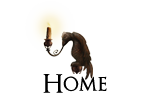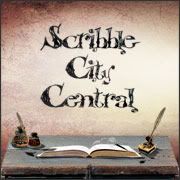Scribble City Central's twentieth Fantabulous Friday comes from Pat Walsh, shortlisted for both The Times Children's Fiction Competiton and the Waterstones Children's Prize. When I read Pat's first novel, The Crowfield Curse, I was entranced by the spot on historical mise-en-scène she creates. I say mise-en-scène advisedly, even though it is a phrase more commonly used of film. Pat's writing is so rich and evocative that it was impossible for me not to see the people and places she describes unrolling quite clearly in my head as a sort of in-brain movie.
Not the least of these was William's hob, Brother Walter - a character she clearly loves down to the last tuft of reddish brown hair on his pointed ears. I wasn't sure how she was going to follow such a fine book, but I needn't have worried. The second Crowfield book - The Crowfield Demon - is darker, but just as much of a triumph. That feel of real medieval history touching the edges of the supernatural world is something Pat does brilliantly - to my mind these books have a flavour of Kevin Crossley-Holland's Seeing Stone trilogy (and that's a high compliment from me), but their originality is all Pat's own. It is with great pleasure, therefore, that I pass you over to Pat to tell you all about:
H for Hob
Guardian and Forest Friend
PW: I met my first hob between the pages of a book, many years ago. The book was Hobberdy Dick by KM Briggs. It was set during the English Civil War and told the story of a hob who looked after a manor house deep in the Cotswolds, and the families who lived there over the years. Witches and a Church Grim, an abbey lubber, ghosts and Will o’ the Wisps flitted through the story, lit by touchwood and corpse lights. It was a mixture that enchanted me and drew me back to the book time and again. Since then, I’ve come across other hobmen, a race of solitary fairy creatures ranging from the small and generally friendly brownies, lobs and hobthrusts to the more sinister Hob Headless and boggarts. We even know the names of some of these hobmen - Robin Goodfellow, Puck and Lob-lie-by-the-fire. They are to be found in the legends and folk tales of northern England and Scotland, and they turn up in fiction from time to time, always bringing an otherworldly sense of mystery and mischief to the proceedings. Amongst the best are Katherine Langrish’s hob in Dark Angels, Linda Newberry’s Lob (though Lob is as much a Green Man as a hob), and William Mayne’s hob in Hob and the Goblins.
‘Hob works when he lives in a house. He tidies away abandoned things, like scraps of quarrel, or pieces of spite. He banishes small troubles, makes ghosts happy, soothes tired curtains, charms kettles into singing, and stops milk sulking.’
This mixture of the cosily domestic and the magical underpins the lives of hobs and I knew long ago that I wanted to write a hob story of my own one day. In the meantime, I read and learned as much as I could about folklore and myths. The best reference book I ever found was A Dictionary of Fairies by Katharine Briggs (the same KM Briggs who wrote Hobberdy Dick). It has been my guidebook to the inhabitants of the Otherworld for more years than I care to remember.
I came across hobmen in other countries, though they went by different names: bwbach in Wales, domovoi in Russia, tontuu in Finland, kobold in Germany, and the Icelandic Yule Boys. I lived in Norway for several years and found an echo of our own home-grown hobs in the Scandinavian nisse and tomten, shy and gentle farm guardians who care for animals and children and keep the farmhouse and barns tidy and clean. A bowl of porridge or a piece of bread and butter is sufficient thanks for a hob’s hard work. But should the farmer offer clothing, then this kindly meant gesture is likely to offend, and the hob may well leave, never to be seen again.
In the Nordic countries these hobmen are an integral part of Christmas and appear in many children’s books, such as The Tomten and The Tomten and the Fox by the Swedish writer, Astrid Lindgren, and illustrated by Harald Wiberg. Wiberg’s snowy, moonlit illustrations perfectly capture the mood of the stories and introduce us to a small, bearded and red-capped tomten, a close cousin of the English hob, as he goes about his nightly work caring for the sleeping inhabitants of his farm.
When I started The Crowfield Curse, I decided that my own hob was going to be a forest creature, living in a burrow beneath an oak tree. In the story, circumstances conspire to bring the hob to a small abbey on the edge of the forest, where he makes friends with an orphaned boy and a crippled monk, and along the way, he gains a name, Brother Walter. From the outset, I saw him clearly in my mind; he was not the little bearded and clothed man of Scandinavian myth, or thin limbed and almost human in appearance like Hobberdy Dick. I saw Brother Walter as a small creature with thick reddish fur and a long tail. With his pointed ears and green-gold eyes, he has more of the fox about him than the gnome. He is inquisitive and fiercely loyal to those who earn that loyalty. He is hard working, as all hobs are, but like his fellow hobmen, he is essentially a wild creature who exists in the shadows beyond the edges of the everyday world. He is, as hobs have always been, a creature of magic and myth, a guardian spirit and a movement caught out of the corner of the eye.
Click here to buy both The Crowfield Curse and The Crowfield Demon on the Scribble City Central Bookshelf
SCC: Hearing about where a writer's inspiration comes from never ceases to fascinate me. Thank you so much, Pat. I'm ashamed to say that I've never read Hobberdy Dick, so shall try and seek it out.
Next week: Steve Feasey, expert on all creatures of the Netherworld, talks about I for Imp. See you then!





















2 comments:
Ah, hobs and lobs are everywhere! Very enjoyable post, Pat - thank you.
Pat made me a fan of hobs! It's wonderful to read more about them. Thanks Pat and Lucy!
Post a Comment